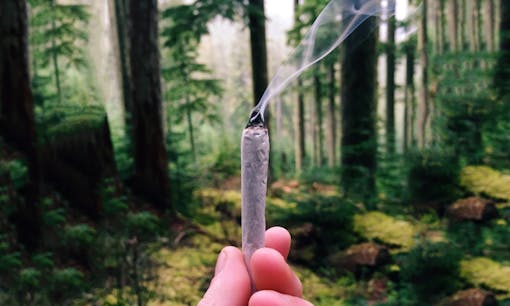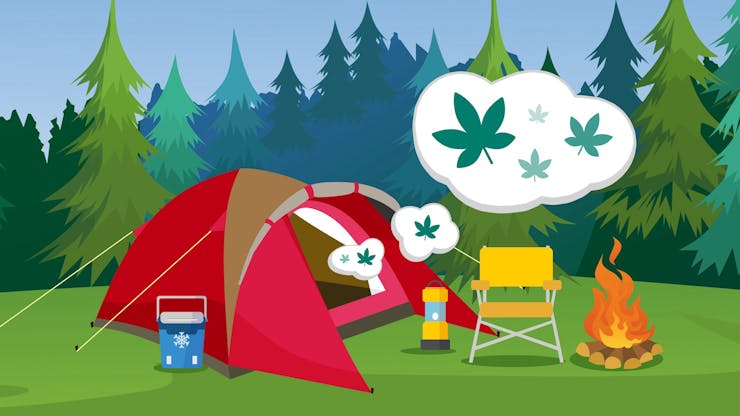Top takeaways in this article:
- Weed is illegal on federal lands like National Parks
- Smoking weed in public is illegal on state lands like state or county parks/campgrounds
- So it’s generally not legal to smoke weed in a public campsite
- If you’re going to do it anyway—don’t bother anyone. And don’t get caught
The seasons are changing, which means more people are dusting off their hiking boots and setting off for adventures in nature. Cannabis is a natural companion for explorers of the great outdoors – there’s something about imbibing between breaths of fresh air that makes us feel more connected to these organic landscapes.
Before shoving off on your journey, make sure you’re equipped with the knowledge you need to be both safe and considerate with your cannabis use. We surveyed a large group of hikers with an affinity for cannabis to determine what tips to keep top-of-mind while outside, so let this be your map to positive experiences in nature.
Safety and etiquette for smoking weed outside

Safety is paramount to having a good experience, and etiquette is paramount to others having a good experience, so be sure to practice both when you hit the trail.
- Be respectful of other hikers. This piece of etiquette was offered by nearly every hiker interviewed—not because cannabis is something that should be kept secret, but because, as one hiker put it, “Just like cigarettes, not everyone likes it, and everyone should be able to enjoy the trail.” This is especially important around crowds and children.
- Leave no trace. This is the golden rule for all hikers— no one is an exception. When it comes to enjoying cannabis on the trail, it may seem like no big deal to toss an extinguished roach. (“It’s okay, the crutch is hemp paper!”) No. No one wants to see cannabis or cigarette butts on the trailside, and even if it seems too small to make any big impact, get in the habit of packing out all trash no matter how small.
- Be conscientious of your use of heat and fire. This is particularly true in dry areas and seasons. Tossing a roach you thought was out could have devastating effects on a dry ecosystem and ruin areas that were once near and dear to many other hikers. And, as always, be smart with your use of campfires (in other words, don’t be a stoned idiot), and adhere to the conditional fire laws in your area.
- Bring extra water. You should always bring more water than you think you’ll need in the event of an emergency, but this is especially true for those of us who like to pair our adventures with cannabis. As you may have noticed with the dry mouth phenomenon, cannabis dehydrates you, so be sure to pack and drink a lot of water. I always bring a water filtration pump with me, because unexpected things can happen.
- Know your route. Some trails are obvious and easy to locate. Other are not. I can’t tell you how many times I’ve missed a switchback or had to retrace steps looking for familiar signs – it can happen to anyone, and being high while trying to navigate can make it even more challenging if you’re not an accustomed user. It may sound dorky, but bring a topography map or a GPS system, pay close attention to natural landmarks, and track your mileage.
Best cannabis pieces to bring hiking and camping

What’s your favorite piece to bring while hiking? We asked our local hikers what they preferred, and here’s what we learned.
- Joints. My personal favorite method for the great outdoors is the classic joint. Roll several before hitting the trail, and you’re good to go. Shop for “dogwalkers”—which are mini-sized joints that are lower-profile and usually less potent.
The upsides to joints: they stay lit even in windy weather, they’re easy to share with friends, they’re lightweight, and they pack a big punch. The downsides: they can be hard to light in the wind, you have to pack out roaches (bring an extra baggie, otherwise they make your backpack smell bad), they require a lot of bud, and a strong breeze makes them burn faster.
- Vape pens. A lot of hikers love vape pens on the trail. The easiest oil and rosin pens offer strain-specific cartridges, so you can bring your favorite variety of cannabis with you on the trail. They’re inconspicuous offer the perfect lift.
Just make sure to charge your vape battery. And store your pen upright so it doesn’t leak.
- Pipes. The tried and true method of consumption favored by many hikers. As one Washington hiker said, “On busier trails I prefer to use a pipe. They’re easier to put out when other people are passing by.” Almost all hikers surveyed cited pipes and one-hitters as their go-to pieces, so there’s something to be said about this classic companion. The downsides: they’re breakable, they can be difficult to light with a breeze, and it’s hard to hit them while walking.
- Travel water pipes. We love a good bubbler when camping. The water cools and filters the smoke, which makes it easier on the parched throat of a camper. Buy a cheap, small glass travel bubbler. Skip the plastic bong.
- Edibles. There’s nothing wrong with eating some edibles and staring at the fire for a few hours. The body high can soothe tired muscles and promote sleep. The downside: edibles can cause an overly intense high with sedating effects. Dose responsibly!
Legal considerations of enjoying cannabis outdoors

There are differences in marijuana policy and tolerances depending on which area of wilderness you’re visiting.
Federal land like national parks can cite you for using marijuana, and technically you can still be fined for public consumption outside national parks even in legal states.
State fines tend to be significantly lower than federal ones, but it’s still something to consider. Fees vary from state to state, so be sure to research your relevant laws if this is a concern.
Private campsites are different than state or federal land, and nowadays some spots advertise their 420 friendliness. Google ‘420 camping’ in your state to see what’s around. There’s Camp Laughing Grass in Maine, or Tree House Joint in Washington.
According to federal agencies:
Possession or use of marijuana inside a National Park Service unit (parks, preserves, rivers and monuments) is prohibited.
National Park Service
And:
Possession or use of any amount of cannabis is still prohibited on all National Forest lands and at all National Forest campgrounds and facilities.
National Forest Service
Penalties include seeing a judge, a minimum $1000 fine and up to one year in prison.
Thinking of smoking in Yosemite or Yellowstone? Keep it low-profile. According to one commenter on Reddit’s camping discussion board:
“There are a handful of rangers who will search your entire vehicle if they smell it in the car, even during a routine stop.”
Reddit.com board comment on r/camping
The top camping states in the US are: California, Washington, Texas, Florida, and New York. The legalization states ban smoking in public, and the prohibition states ban simple possession.
For example, in California, smoking or vaping on a beach can yield a $25 fine. Oddly enough, smoking in the parking lot might be OK, though.
“PRC Section 5008 includes exemptions that allow smoking and vaping tobacco and marijuana in State parks and beaches in the following areas or under the following circumstances: paved roadways or parking facilities, …”
According to Washington State parks officials: “Cannabis use is not permitted in public spaces.”
In closing, living in a society means conforming to behaviors that don’t hurt anyone, or generally bother them too much. That includes how you act on public lands like state and federal parks and campgrounds.
Smoking weed has the potential to make a cool hike even cooler. We have some great memories of joints with friends around a campfire.
But just cus it’s cool and fun does not immunize you from the law or basic manners. Do your thing in nature—just leave no trace and don’t be a jerk about it. And if you get caught, be prepared to pay the fine.
Leafly updated this article for the 2024 camping season. Leave any other tips in the comments below.





